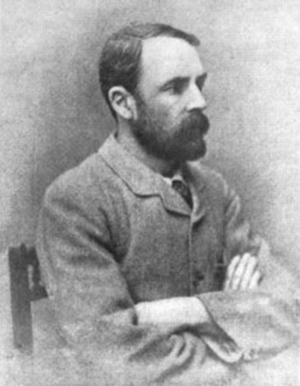Charles Francis Keary facts for kids
Quick facts for kids
Charles Francis Keary
|
|
|---|---|

In The Sketch, 18 December 1895
|
|
| Born | 29 March 1848 Trent Vale, England
|
| Died | 25 October 1917 (aged 69) London, England
|
| Education | |
| Occupation | Scholar, historian |
Charles Francis Keary (born March 29, 1848 – died October 25, 1917) was an English scholar and historian. He also became a novelist later in his life. His books even influenced famous writers like James Joyce.
Contents
Early Life and Education
Charles Keary was born in Trent Vale, England, on March 29, 1848. His family was from Galway, Ireland, but they had moved to Stoke-on-Trent. His father, William Keary, became the first mayor of Stoke-on-Trent in 1874. Charles went to school at Marlborough College. He then studied at Trinity College, Cambridge, where he earned his degree.
Expert in History and Coins
After college, Keary became very interested in Scandinavian history and old mythology. This was a new and exciting area of study at the time. He wrote several important books on these topics. His book The Vikings in Western Christendom (published in 1890) was considered a top book for many years. He also became an expert on Norway and its people. He even knew many Norwegian poets and writers.
From 1872 to 1887, Keary worked at the Department of Coins at The British Museum in London. Here, he studied and wrote about old coins. He helped publish a big book called A Catalogue Of English Coins In The British Museum: Anglo-Saxon Series in 1887. He also wrote articles about coins for special journals. In 1894, he received a medal from the Royal Numismatic Society for his work with coins. During his time at the British Museum, he was best friends with Francis Ysidro Edgeworth, a well-known philosopher.
Writing Novels and Stories
Later, Keary decided to write novels instead of just history books. He was inspired by Russian novelists of his time. His novels were quite unique. They didn't always follow a normal story structure. This was his way of showing how messy and unpredictable real life can be. He also observed characters very closely.
One of his novels, The Two Lancrofts (1893), explores the lives of writers from Oxford University to Paris. His book Herbert Vanlennart (1896) was based on his trip to India. He had written about this trip in a shorter travel book called India: Impressions (1903). Another novel, Bloomsbury (1905), was inspired by his experiences in the literary circles of Bloomsbury, London, in the late 1880s and early 1890s.
He also wrote a very unique prose work called The Wanderer: From the papers of the late H. Ogram Matuce (1888). He used the pen name H. Ogram Matuce for this book. People remembered The Wanderer as an important book even many years later.
Keary also tried writing plays in verse, like The Brothers: a Fairy Masque (1902). He had more success with philosophy, writing The Pursuit of Reason (1910). Sadly, he died from a heart attack in London on October 25, 1917. Another book, The Posthumous Poems of C. F. Keary, was published after he passed away in 1923. His death happened during World War I, which meant his work was quickly forgotten by many.
His collection of short stories, Twixt Dog and Wolf (1901), had strange and scary elements. These stories influenced James Joyce's famous novel Dubliners. Joyce even mentioned this in a letter in 1905. A fantasy historian named Douglas A. Anderson said that Twixt Dog and Wolf contained "literary weird fiction of a high order."
Music and Folk Songs
Charles Keary wrote the words (called the libretto) for the opera Koanga (1904). The music for this opera was composed by Frederick Delius. They had many talks about the opera, but their work together was difficult and didn't last long. Keary even based a character in his novel The Journalist on Delius.
Charles's sister was Alice Annie Keary. She was a folklorist from Staffordshire and collected folk songs. She was also a close friend of the famous folklorist Charlotte Sophia Burne. Charles Keary himself traveled in Europe and also collected folk songs. He wrote articles about them, like "Roumanian Peasants and their Songs."
Selected Works
- The Dawn of History, 1878
- The Mythology of the Eddas, 1880
- Outlines of primitive belief among the Indo-European races, 1882
- The Morphology of Coins, 1886
- The Vikings in Western Christendom, A.D. 789 to A.D. 888, 1891
- Norway and the Norwegians, 1892
- The Two Lancrofts, 1893
- Herbert Vanlennert, 1895
- The Journalist, 1898
- The Pursuit of Reason, 1910

